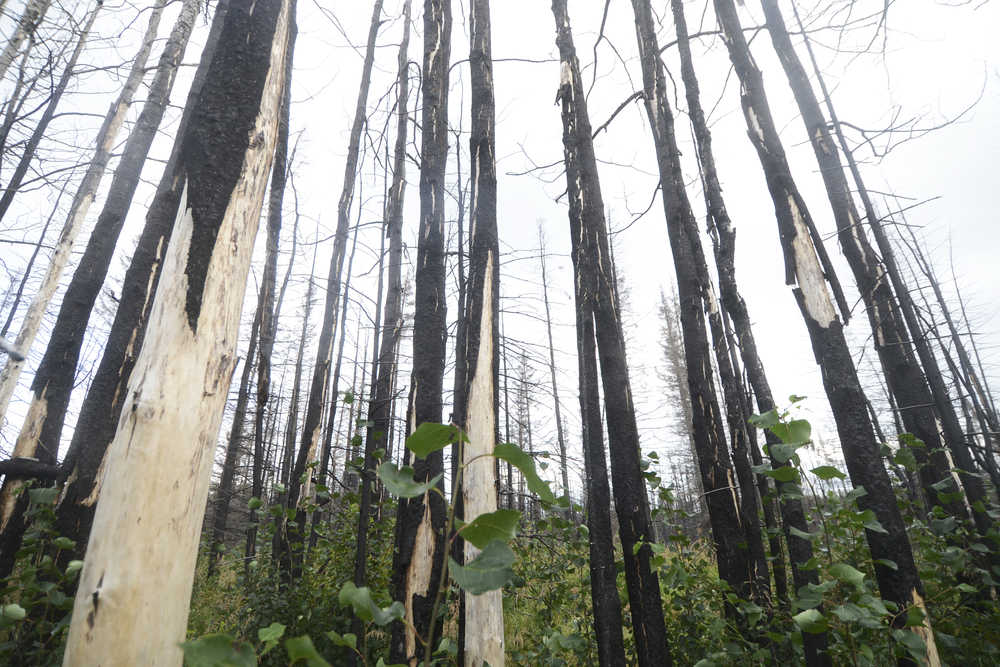Editor’s note: This story has been updated to reflect that the Division of Forestry, not including the Office of Emergency Management, sent personnel around the state and to the Lower 48 to help with other fires.
The Kenai Peninsula got a break this fire season with no major burns, but local agencies stayed busy with prevention and other fire suppression work.
The Funny River fire consumed six structures and nearly 200,000 acres in 2014, while last year’s Card Street burned across more than 8,800 acres and took 11 structures in its wake, according to the Alaska Interagency Coordination Center. Both were human caused.
This year’s fire season got off to an earlier and hotter start than usual, said Area Forester Hans Rinke at the Soldotna office of the Alaska Division of Forestry. While the peninsula escaped another large burn, there was plenty of opportunity for one throughout May and June, and for the beginning of July, he said.
“We had times where we could have had large fire growth,” Rinke said, referencing the lack of snowpack and high spring temperatures that fanned many fires around the state as early as April.
More typical weather patterns of alternating sun and rain took over later in the season, which Rinke said was a factor in the peninsula avoiding a large fire. Still, Division of Forestry firefighters were busy this season taking care of brush fires and other small burns that continually cropped up, he said, as well as addressing several “holdover” fires from Funny River and Card Street.
They were also sent out to fight fires across Alaska and in the Lower 48, Rinke said.
“Our staff is basically engaged … whether it’s a busy fire season or not in Alaska,” he said.
The same is true of U.S. Fish and Wildlife Service personnel who work for the Kenai National Wildlife Refuge. Nathan Perrine, a fire operations and fuels technician, said some staff members are currently down in California helping with fire suppression efforts.
The lack of a large burn on the peninsula, though, has let refuge staff focus on prevention this season, he said.
“It definitely let us concentrate on putting our fuel breaks in this year,” Perrine said.
Work to improve an existing fuel break in the Funny River area was done, and a start was made on a new fuel break in the Sterling area in the wake of Card Street, Perrine said.
The Kenai Peninsula Borough’s Office of Emergency Management also took advantage of the quieter fire season, said Director Scott Walden.
“It did relieve us of having to send a lot of our resources out in the field, that’s for sure,” he said of the break.
Walden’s office was able to focus this year on pushing prevention programs such as Firewise, which Walden said began several years ago and is being continued. “The community’s been great,” in terms of reception to the program, Walden said.
“We were able to take advantage of the uninterrupted time to conduct that training,” he said.
The lack of a major fire on the peninsula also provided some respite from the cost of containing one. While agencies like local fire departments, the Office of Emergency Management and the Division of Forestry are reimbursed for their fire suppression efforts through pre-established agreements, some of that burden falls on the state rather than the federal government depending on how much of the fires burn on federal versus private lands.
Last year’s Card Street fire cost just more than $6.7 million total, while the Funny River fire in 2014 cost nearly $11.5 million altogether, according to data from the Alaska Interagency Coordination Center.
As far as the actual refuge is concerned, Perrine said areas that have been burnt by the last two fires are not expected to burn again any time soon, so staff lets “mother nature do her thing” while the land rejuvenates. Time not spent actively fighting a wildfire is spent preparing for the next inevitable one, Perrine said.
“I think we’re ready to deal with anything that comes our way,” he said.
Reach Megan Pacer at megan.pacer@peninsulaclarion.com.

